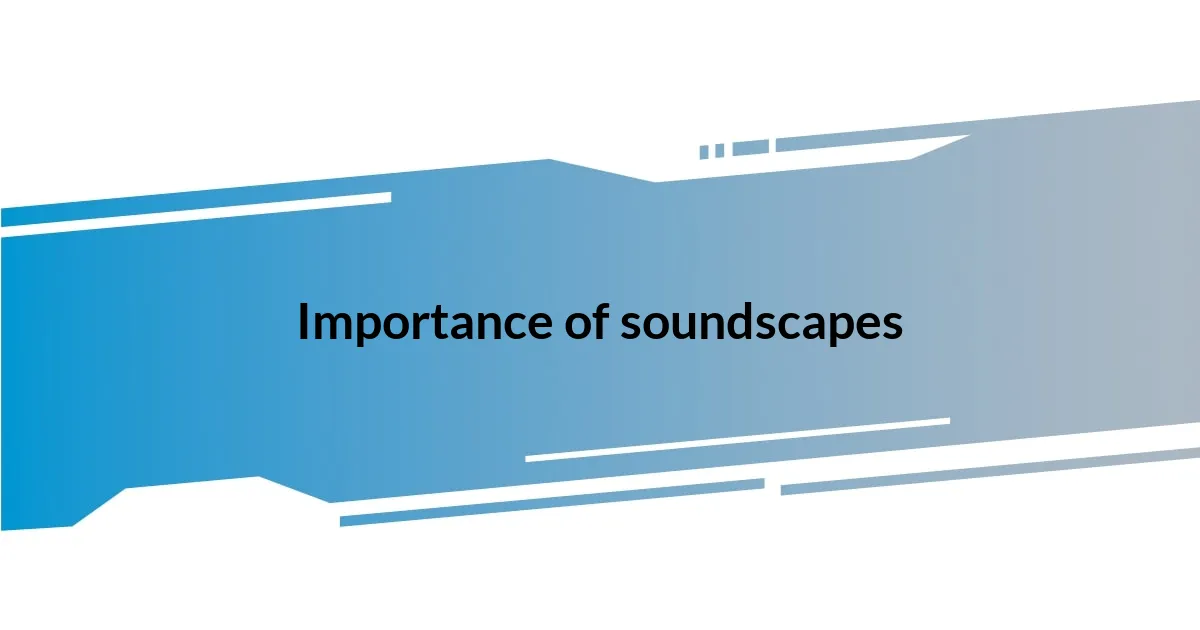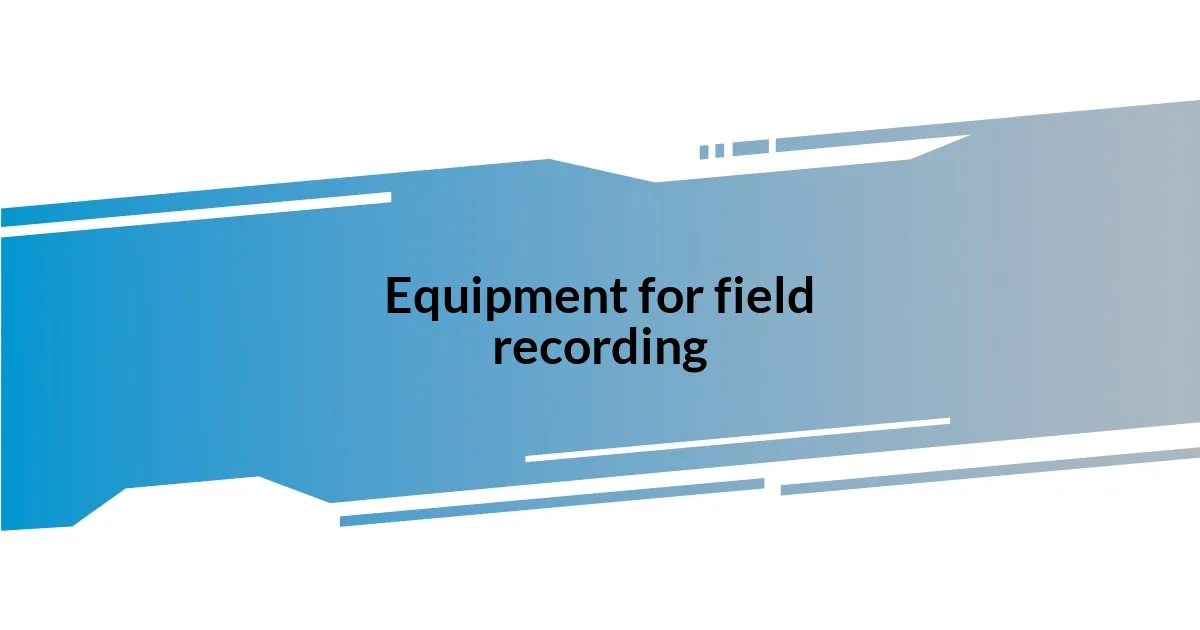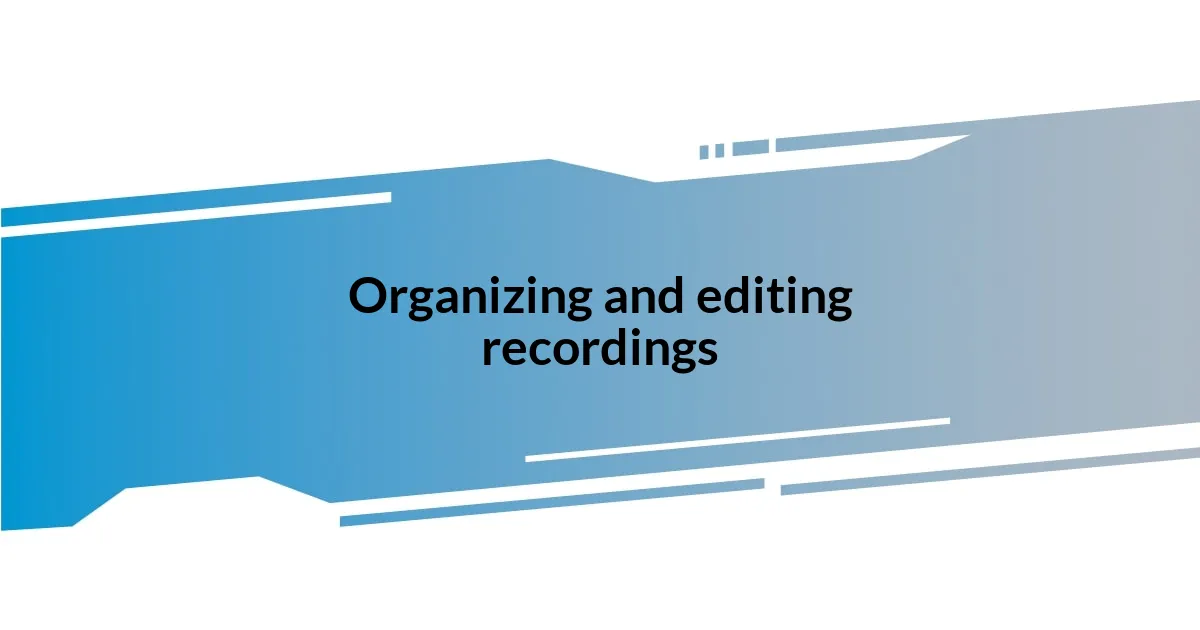Key takeaways:
- Field recordings capture the essence of environments, evoking memories and emotions through sound.
- Soundscapes shape experiences and enhance mindfulness, altering moods and fostering deeper connections with surroundings.
- Effective field recording requires preparation, quality equipment, and storytelling to create immersive auditory journeys.
- Sharing recordings can create shared experiences and emotional connections with audiences, leveraging social media and communal listening events.

Understanding field recordings
Field recordings capture the essence of a location, transforming sounds from the world around us into a vivid auditory experience. I remember the first time I recorded the gentle ripples of a nearby lake at dawn; those soft, almost whispering sounds invited me into a meditative state. Isn’t it fascinating how a simple sound can transport us back to a specific moment or place?
As I dove deeper into field recordings, I realized they’re not just about the sound itself, but the story behind it. Each recording is a snapshot of that specific environment, infused with its unique character, like the rush of traffic or the chirping of birds. Have you ever paused to think about how these sounds shape our memories and feelings? I often find myself reflecting on how the low hum of city life juxtaposes against the tranquil rustle of leaves—each evokes a different mood, allowing us to connect with diverse experiences.
The beauty of field recordings lies in their ability to remind us of the world’s vibrancy. On one occasion, I ventured into a bustling market, immersing myself in the cacophony of vendors and shoppers. That chaos, recorded authentically, now serves as a reminder of life’s energy. Isn’t it amazing how these auditory snapshots ignite emotions and memories, making us feel alive, even in the absence of visual cues?

Importance of soundscapes
Soundscapes play a crucial role in shaping our experiences and understanding of the world. I’ve often found myself drawn to the rich tapestry of sounds in a quiet forest, where leaves rustle and distant bird calls create a symphony of nature. Those peaceful moments remind me how sound can ground us and provide a sense of presence, emphasizing the importance of mindful listening in our daily lives.
To put it simply, soundscapes can influence our emotions and thoughts profoundly. Here’s why they matter:
- They evoke memories vividly, allowing us to relive past experiences.
- They create a sense of place, helping us connect to different environments.
- They can alter our mood, with certain sounds calming or energizing us.
- They foster awareness of the world around us, encouraging deeper engagement with our surroundings.
I remember standing by a flowing river, the rush of water mingling with the soft chirping of insects. That blend made me reflect on the inherent beauty surrounding us, urging me to pay closer attention to the often-overlooked sounds in our daily lives. Each note tells a story, and that’s what makes soundscapes so powerful.

Techniques for effective field recording
When it comes to effective field recording, preparation is key. From my experience, always scouting your location beforehand can make a significant difference. For instance, I once arrived at a busy festival without knowing where the sound peaks would be. It turned out that the best acoustics were near a food stall. I learned the importance of being strategic about placement—sometimes, it’s all about finding that sweet spot to capture the essence of the moment.
Additionally, I cannot stress enough the value of using the right equipment. A high-quality recorder and microphones can truly enhance your results. On one outing, I used a handheld recorder with windshields in a windy area, which dramatically improved the clarity of the sounds I captured, allowing for a more immersive listen later. Have you experienced the frustration of recording in less-than-ideal conditions? It’s a learning curve, but the right tools and techniques can elevate your work significantly.
Lastly, don’t underestimate the power of storytelling through your recorded sounds. I remember capturing the sounds of a local fisherman preparing for a day at sea. His rhythmic movements and the clinking of tools told a deeper story than words ever could. If you weave these sounds into a narrative, it becomes not just a recording but a journey for the listener. Have you ever thought about how a sound can evoke a story? That’s the beauty of field recordings—it’s about creating connections through sound.
| Technique | Description |
|---|---|
| Preparation | Scouting the location beforehand improves sound capture. |
| Right Equipment | Using quality gear enhances clarity and detail. |
| Storytelling | Incorporating narrative turns recordings into immersive journeys. |

Equipment for field recording
When choosing equipment for field recording, I always recommend starting with a quality portable recorder. On one of my first trips, I used a basic model and found it challenging to capture the nuances of ambient sounds. I learned that a higher-end recorder with better dynamic range made all the difference. With the right tools, you’ll hear subtle layers in soundscapes that enhance your recordings.
Microphones are equally crucial to your setup. I’ve experimented with different types, from shotgun mics to omnidirectional ones, and each serves a unique purpose. For instance, I recall a day spent at the beach where using an omnidirectional mic allowed me to capture the ocean waves and the laughter of children, blending different environments perfectly. What I realized is that selecting the right microphone for your surroundings can transform your recordings into rich auditory experiences.
Don’t forget about accessories like windshields and tripod stands; they can greatly improve your sound quality. I remember a windy day in a canyon, and the wind noise nearly ruined my recordings. It was only after I invested in a good windshield that I could finally record the beautiful echoes of nature. Have you ever found yourself battling the elements during a recording? With the right accessories, you can focus on creativity instead of technical difficulties, leading to a more satisfying field recording experience.

Organizing and editing recordings
When it comes to organizing recordings, I’ve found that a well-structured file system is essential. After one particularly chaotic recording session, I lost hours of data because I didn’t label tracks properly. Now, I always create a folder for each project, with subfolders for different locations or days of recording. This way, it’s so much easier to find what I’m looking for later. Have you ever spent frustrating minutes searching for a specific sound? A little organization can save you a lot of time.
Editing is where the magic truly happens. It’s not just about cutting out mistakes; it’s about crafting a narrative. One time, while editing a nature walk, I discovered a whisper of the wind through the trees that tied the whole piece together. I spent hours refining that moment, and it was worth every minute. It’s fascinating how small details can shape the listener’s experience. Have you ever gone back to a recording and found a hidden gem that changed everything?
I also encourage using software that allows for layering sounds. On one project, I combined the sounds of a bustling city street with the distant notes of a street musician. The result was an immersive piece that transported listeners right into the heart of the urban scene. I believe that layering isn’t just a technical skill; it’s an art form that can create a rich tapestry of sound. Have you experimented with blending different recordings? What stories could your sounds tell if you let them intertwine?

Creative uses of field recordings
Creative uses of field recordings can transcend traditional boundaries, inspiring countless artistic expressions. I remember a captivating night when I recorded the sounds of a late summer gathering in my neighborhood. Those simple conversations and laughter, once woven into a sound collage, transformed into the backdrop of a short film that captured the essence of community. It’s incredible how everyday sounds can evoke deep emotions and narratives—have you considered how your recordings might tell your own story?
Another interesting endeavor I pursued was using field recordings in music. One afternoon, I captured the rhythmic sounds of rain tapping against my window and layered it into a song I was composing. The result was enchanting—a natural metronome that added a depth I could never achieve with artificial sounds alone. It’s a testament to how field recordings can breathe life into music; have you tried integrating real-world sounds into your compositions?
Moreover, I’ve found great potential for using field recordings in mindfulness and meditation practices. While experimenting with ambient sounds, I created a calming audio piece that featured soft wind chimes and distant bird calls. Listening to it became a meditative escape, helping others to unwind and reconnect. Isn’t it fascinating how sound can influence our mental state? By thoughtfully curating these recordings, you can create a soothing experience that resonates on a personal level for listeners.

Sharing your field recordings
Sharing your field recordings can be a rewarding experience, both for you and your audience. I remember the first time I shared a collection of sounds from a serene lakeside trip. The response was overwhelming; listeners described how those gentle waves transported them back to their own peaceful moments. Isn’t it wonderful to realize how sound can create shared memories, connecting us in unexpected ways?
When it comes to sharing, social media has been a fantastic platform for me. I once posted a series of clips from a vibrant local market, capturing everything from vendors shouting their deals to the laughter of children playing nearby. The engagement was remarkable. People began to share their experiences of visiting markets, sparking conversations and even collaborations. Have you thought about how your recordings could resonate with others in such a vibrant way?
Additionally, I’ve found that hosting listening sessions can create a deeper connection with your audience. After one particular event where I played recordings from a rainstorm I’d captured, I noticed how the audience collectively sighed, reflecting on their own experiences with rain. This communal listening experience turns something personal into a shared journey. Have you ever listened closely with someone else and discovered a new layer to a familiar sound? It’s in those moments that you realize the power of your recordings goes far beyond mere sound—it’s about creating connections and evoking emotions.